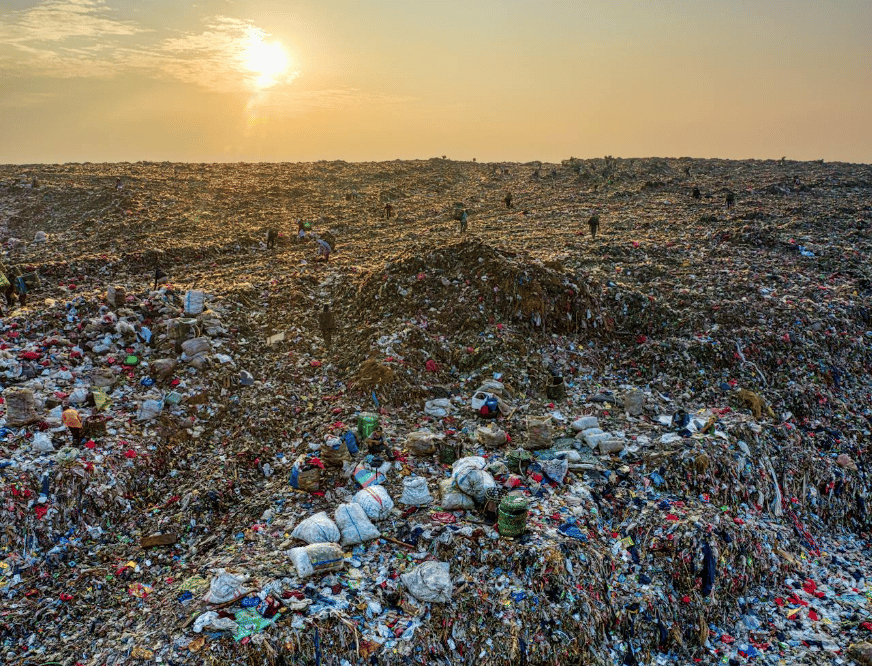SOLD OUT! - CHEWIE FOUNDERS 1000 - BATCH II
Out of Sight, Out of Mind: The Reality of Landfills
In many parts of the world, the waste collected from households is often dumped into landfills, out of sight and out of mind for most of us. However, recent news has highlighted growing public discontent with these practices.
8/4/20244 min read


Ever wondered what happens to the garbage we throw away every day? In Bangalore, for instance, around 4,000 to 5,000 tons of solid waste are generated daily, most of which ends up in landfills. While landfills are essential for waste management, they have significant environmental impacts, from releasing methane gas to contaminating soil and water.
In many parts of the world, the waste collected from households is often dumped into landfills, out of sight and out of mind for most of us. However, recent news has highlighted growing public discontent with these practices. For example, in 2024, protests erupted in India against the overflowing landfills in the outskirts of Delhi. A similar protest left the tech city Bengaluru stinking for weeks when residents of Mittaganahalli protested against landfills near their villages. Similarly, UK residents near Fleetwood landfill voiced their concerns over health risks and pollution , while in the United States, communities near the Bridgeton Landfill in Missouri protested against the toxic fumes affecting their daily lives. The landfill fire in Alabama last year polluted the air for miles and sickened people and animals far and wide.
These protests highlight a global issue: the impact of landfills on local communities is becoming increasingly difficult to ignore. People living near these sites are raising their voices, demanding better waste management practices and more sustainable solutions. This is not just a local issue; it's a worldwide challenge that requires our immediate attention.
Understanding Landfills
Landfills are designated areas for waste disposal, with different types serving various purposes, such as sanitary landfills for household trash and industrial landfills for commercial waste. Unlike traditional open pits, modern landfills are designed to contain waste and prevent environmental contamination, although this also means the waste does not decompose as it might in other settings.
Environmental Impact
Methane Emissions: When organic waste decomposes in the absence of oxygen in landfills, it releases methane, a potent greenhouse gas. Methane is much more effective at trapping heat in the atmosphere than carbon dioxide, making it a significant contributor to climate change. Landfills generate a mix of gases, with methane making up about 50%, carbon dioxide about 45%, and water vapor about 5%, accounting for approximately 12% of global methane emissions. This level of emission is equivalent to the pollution from 23.1 million gasoline-powered cars each year.
Leachate: As waste breaks down and rainwater filters through landfills, it creates a toxic liquid known as leachate. This liquid can seep into the ground, contaminating soil and groundwater and posing serious environmental and health risks to nearby communities.
Contamination: The toxic substances in landfills can leach into the surrounding environment, affecting both ecosystems and human health. Heavy metals and other pollutants can enter the soil and water, impacting plant and animal life and potentially entering the food chain. In the U.S., landfills receive about 146 million tons of waste annually, which amplifies these problems.
Space Issues: The growing volume of waste is leading to a shortage of landfill space globally. Some estimates suggest that we are running out of landfill space at a rate of one per day worldwide.
Waste Management Practices
Modern waste management strategies, such as recycling and composting, are crucial for diverting waste away from landfills and reducing their environmental footprint. For example, municipal garbage trucks collect waste from 300-500 households per trip, amounting to approximately 8-10 tons per load, illustrating the vast amounts of waste managed daily.
Innovations in waste management, such as methane capture systems, allow us to convert landfill gas into energy, thereby reducing harmful emissions. Additionally, waste-to-energy technologies and improved recycling processes are transforming how we deal with waste. Plastic bags, for instance, can take 10 to 100 years to degrade in landfills, while glass takes even longer, emphasizing the need for better recycling efforts. Some landfills are equipped to capture methane and convert it into energy, which helps mitigate their environmental impact.
Companies like Mankomb are leading the way with innovative solutions like their fully automatic home food waste management appliance. This technology significantly reduces the amount of organic waste that ends up in landfills, addressing the issue at its source.
Future Trends and Sustainability
The future of waste management involves reducing waste, increasing recycling rates, and adopting zero-waste living practices. These efforts not only protect the environment but also promote a more sustainable society. There is a growing call for waste reduction, more recycling, and holding producers accountable for single-use plastics.
Effective waste management also depends on robust policies and regulations. Governments must enforce stricter landfill regulations and support recycling and composting initiatives. Judicial actions, such as those by the Karnataka High Court that led to the creation of the Municipal Solid Waste Management Rules in 2016, can drive significant improvements. Often, effective waste management solutions require judicial intervention and sustained public pressure.
Public awareness and community involvement are vital for reducing landfill waste. Grassroots movements and local initiatives are key to promoting sustainable practices.
Takeaway
While landfills are a critical component of our waste management system, their environmental impact is a serious concern. By adopting better waste management practices, embracing technological innovations, and engaging in community efforts, we can mitigate these effects.
Everyone can play a role by recycling more, supporting environmental policies, and using innovative solutions like Mankomb’s home food waste management appliance.
With ongoing advancements and collective efforts, we can envision a future where waste management is more sustainable and environmentally friendly. How will you help reduce landfill waste in your community?
Support
E: social@mankomb.com
M: 9739243943 (9am-5pm)
Connect
Connect. Follow. Stay connected
Copyright © 2025 | Mankomb Technologies | All Rights Reserved
